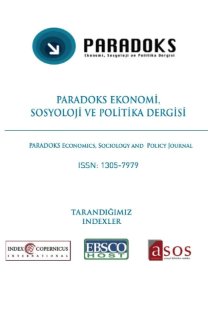Döviz Kurlarının Makro Ekonomik Değişkenler Üzerine Etkileri: Seçilmiş Yükselen Ekonomiler Üzerine Bir Çalışma
ParasalAktarımMekanizması, DövizKuruKanalı, Türkiye, Arjantin, VAR
The Effects Of Exchange Rates On Macroeconomic Variables: A Study On The Selected Emerging Market Economies
Monetary Transmission Mechanism, Exchange Rate Channel, Turkey, Argentina, VAR,
___
- Arat, K. (2003), “Türkiye’de Optimum Döviz Kuru Rejimi Seçimi ve Döviz Kurlarından Fiyatlara Geçiş Etkisinin İncelenmesi”, Uzmanlık Yeterlilik Tezi, TCMB Dış İlişkiler Genel Müdürlüğü, Temmuz, Ankara.
- Ardıç, O. P. and F. Selçuk(2006),“The Dynamics of a Newly Floating Exchange Rate: The Turkish Case”,Applied Economics, 38(8): 931-941.
- Artus, P., A. Cartapanis and F. Legros(2003),“Towards a Macroeconomics of Exchange Rate Regimes”,Revue économique, 54(5):905-912.
- Asteriou, D. and S.G. Hall (2007),Applied Econometrics: A Modern Approach, Palgrave Macmillian, New York.
- Başçı, E., Ö. Özel and Ç. Sarıkaya (2008),“The Monetary Transmission Mechanism in Turkey: New Developments”, Bank for International Settlements (BIS) Papers No. 35, March Basel.
- Boivin, J., M.T. Kiley and F.S. Mishkin(2010),“How Has the Monetary Transmission Mechanism Evolved over Time”, NBER Working Paper, No.15879, April.
- Bordo, M. D. and A. J. Schwartz(1988), “Transmission of Real and Monetary Disturbances under Fixed and Floating Exchange Rates”, Cato Journal, 8(2): 451-475. Büyükakın, F., V. Cengiz and A.
- Türk(2009),“Türkiye’dePara
- PolitikasıAktarımMekanizması:
- DövizKuruKanalıÜzerineBirDeğerlendirme”,DokuzEylülÜniversitesiİktisadiveİdariBili
- mlerFakültesiDergisi, 24(1): 171-198.
- Caramazza, F., J. Aziz(1998),“Fixed or Flexible?Getting the Exchange Rate Right in the 1990s”, International Monetary Fund, Economic Issues no. 13, April.
- Catik A., Martin C. (2012),“Macroeconomic Transitions and the Transmission Mechanism: Evidence from Turkey”,Economic Modelling, 29(4): 440–1449.
- CBRT (Central Bank of the Republic of Turkey)(2009), Monetary and exchange rate policy December,http://www.tcmb.gov.tr/yeni/announce/2010/Mon_Exc_Pol_2010.pdf, (ErişimTarihi: 01/08/2012). Bank of the Republic of Turkey,
- CBRT (Central Bank of the Republic of Turkey) (2010), Monetary and exchange rate policy for http://www.tcmb.gov.tr/yeni/announce/2010/Mon_Exc_Pol_2011.pdf, 01/08/2013). Bank of the Republic of Turkey, December, (ErişimTarihi:
- Çiçek, M. (2005)“Türkiye’deParasalAktarımMekanizması: Var (vektörotoregregrasyonu) YaklaşımıylaBirAnaliz”,İktisatİşletmeveFinans, 20(233):82-105.
- DoS (U.S. Department of State)(2009), Background note: Argentina. Bureau of Western Hemisphere (ErişimTarihi: 27.03.2014). (July),
- http://www.state.gov/r/pa/ei/bgn/26516.htm,
- Drabek, Z. and J.C. Brada(1998),“Exchange Rate Regimes and the Stability of Trade Policy in Transition Economies”, Journal of Comparative Economics, 26(4): 642-668.
- DTM (DışTicaretMüsteşarlığı), (2002), Arjantin ve Türkiye Ekonomik Krizleri, Ankara, http://www.foreigntrade.gov.tr/dtmadmin/upload/EAD/KonjokturIzlemeDb/arjantin. doc (Erişim Tarihi:10.01.2013).
- Edwards, S. (2002),“The Great Exchange Rate Debate after Argentina”,NBER Working Paper, No.9257, October.
- Erdoğan, S. and D.Ç.Yıldırım(2008),“Türkiye’de Döviz Kuru Kanalının İşleyişi: VAR Modeli ile BirAnaliz”,İstanbul ÜniversitesiSiyasalBilgilerFakültesiDergisi,39: 95-108.
- Ertekin, M. (2003), Exchange Regimes and Impacts on Foreign Trade of Turkey. Republic of Turkey Ministry of Economics, http://www.ekonomi.gov.tr/upload/BF09AE98-D8D3- 8566-4520B0D124E5614D/Murat_Ertekin-ingilizce.pdf. (ErişimTarihi: 23.03.2014).
- Frenkel, R. (2004), “Real Exchange Rate and Employment in Argentina, Brazil, Chile and Mexico”,İktisatİşletmeveFinans, 19(223): 29-52.
- Frenkel, R. and M. Rapetti(2007),“Argentina’s Monetary and Exchange Rate Policies after the Convertibility Regime Collapse”, CEPR Reports and Issue Briefs,No. 2007-12, April.
- Frenkel, R. and M. Rapetti (2010), “A Concise History of Exchange Regimes in Latin America”, CEPR Reports and Issue Briefs, No. 2010-11, April.
- F. Alejandro and F. Amico(2010),“Exchange Rate Policy, Distributive Conflict and Structural Heterogeneity. The Argentinean and Brazilian Cases”,International Conference Sraffa's Production of Commodities by Means of Commodities 1960- 2010, Roma Tre University, Faculty of Economics, Roma, December 2-4.
- Görmez, Y. and G. Yılmaz(2007),“The Evolution of Exchange Rate Regime Choices in Turkey”, Proceedings of OeNB Workshops No.13,Oesterreichische National Bank, April.
- Gündüz, L. (2001),“Türkiye’deParasalAktarımMekanizmasıveBanka KrediKanalı”,İMKB Dergisi, 5(18): 13-30.
- Hsing, Y. (2004), “Responses of ArgentineOutput to Shocks to Monetary Policy, Fiscal Policy and Exchange Rates: A VAR Model”,Applied Econometrics and International Development, 4(1): 21-36.
- IMF (International Monetary Fund)(2004), The IMF and Argentina 1991-2001,The IMF Evaluation Report,http://www.imf.org/external/np/ieo/2004/arg/eng/pdf/report.pdf, (ErişimTarihi: 23.03.2014). Kasapoğlu, Ö.
- (2007),“ParasalAktarımMekanizmalarıTürkiyeiçinBirUygulama”,
- UzmanlıkYeterlilikTezi, TCMB, PiyasalarGenelMüdürlüğü, Şubat, Ankara.
- Kasman, S., and D. Ayhan(2006),“Macroeconomic Volatility under Alternative Exchange Rate Regimes in Turkey”, Central Bank Review, 6(2): 37-58.
- Magud N., Reinhart C. and E. Vesperoni(2012),“Capital Inflows, Exchange Rate Flexibility and Credit Booms”, IMF Working Paper No.12/41,February.
- Mishkin, F.S. (1995),“Symposium on the Monetary Transmission Mechanism”,The Journal of Economic Perspectives,9(4): 3-10.
- Mishkin, F.S.(1996), “The Channels of Monetary Transmission: Lesson for Monetary Policy”, NBER Working Paper No. 5464, February.
- Mishkin, F.S.(2001), “The Transmission Mechanism and the Role of Asset Prices in Monetary Policy”, NBER Working Paper No. 8617, December.
- Mishkin, F.S. (2007),Money, Banking and Financial Markets,Pearson Education Inc: Boston.
- Muço, M., P. Sanfrey and A. Taci (2004),“Inflation, Exchange Rates and the Role of Monetary Policy in Albania”,European Bank Working Paper No. 88, August.
- Obstfeld, M. (1984),“Capital Flows, The Current Account and the Real Exchange Rate: Consequences of Liberalization and Stabilization”, NBER Working Paper No. 1526, April.
- Örnek, İ. 2009. Türkiye’deparasalaktarımmekanizmasıkanallarınınişleyişi.MaliyeDergisi 156: 104-125.
- Öztürkler, H. and A. H. Çermikli(2007),“Türkiye’deBirParasalAktarımKanalıOlarak Banka Kredileri”, FinansPolitik&EkonomikYorumlar,44(514): 57-68.
- Padilla, J. L. (2010),“How Does Monetary Transmission Mechanism Impact Output, Inflation and Money Market Funds in Argentina? A VAR Approach”, Working Paper Series, University of Lausanne - School of Economics and Business Administration, February. Saraçoğlu, B. and N. Köse(1999),“VektörOtoregresyonYaklaşımıileEnflasyonlaMücadeledePolitikaSeçimi: TürkiyeÖrneği 1980-1996”,İktisatİsletmeveFinans, 14(159): 12-27.
- Sims, C.A. (1980),“Macroeconomics and Reality”,Econometrica, 48(1):1-48.
- Spiegel, M. M. (2002),“Argentina's Currency Crisis: Lessons for Asia”,FRBSF Economic Letter, 25: 1-4.
- Uygur, E. (2010),“The Global Crisis and the Turkish Economy”, Turkish Economic Association Discussion Paper No.3, Ankara.
- Vargas, L. C. (2009),“Capital Flows and Real Exchange Rate Depreciation Effects on the Business Cycle in Emerging Markets”,Journal of Business and Policy Research, 4(2): 72- 92.
- Yağcı, F. (2001), “Choice of Exchange Rate Regimes for Developing Countries”, Africa Region Working Paper Series, World Bank, No.16, April.
- Yılmaz, D. (2009),“Turkey’s Monetary and Exchange Rate Policy for 2009”, Bank for International http://www.bis.org/review/r090115d.pdf?frames=0, (ErişimTarihi: 27.03.2014). Settlements (BIS) Papers No. 3,
- ISSN: 1305-7979
- Yayın Aralığı: Yılda 2 Sayı
- Başlangıç: 2005
- Yayıncı: Sema AY
İtalya’da Endüstrileşme Sürecinde Devletin Rolü Üzerine Bir Tartışma
İhracatta Örgütlenme Modeli Olarak Sektörel Dış Ticaret Şirketleri ve Türkiye’deki İşlevselliği
Süreç İyileştirmenin İşletme Performansına Etkileri
Öğr.gör. Yeşim KAYGUSUZ, Prof.dr. Sait KAYGUSUZ
Asist.prof. Birgül CAMBAZOĞLU, Assoc. Prof. Hacer Simay KARAALP, Dr. Konstantinos VERGOS
